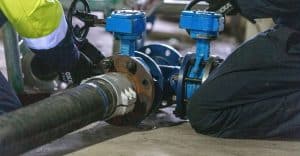Suitable for:
Carbon steel, stainless steel, alloys with chrome or P91/92
Removes:
Iron oxides (rust)
The VPX One Step® process has been developed by Vecom and consists of cleaning with a pH neutral liquid, whereby the iron oxides are dissolved and the underlying steel is passivated (by means of phosphate formation).
With this process, pickling and passivating is done in 1 step. The fact that no other cleaning liquid or addition of chemicals is required to passivate is a major advantage because less environmentally harmful substances are required. VPX One Step® also contains no toxic / corrosive components, making the chemical cleaning a very environmentally and human-friendly method.
Due to the very mild environment of VPX One Step® there are no problems if the installation contains other metals in addition to carbon steel, such as copper, aluminium, zinc or stainless steel. VPX One Step® hardly or does not corrode these metals and there is no plating. VPX One Step® cannot be used to remove welding skin, mill scale, glowing skin & silicate compounds;
After cleaning, a rinsing step is carried out, whereby the waste released has a volume of 2 times the content. VPX One Step® also has major benefits for waste water treatment. The waste water can easily be processed with the DND method.
Advantages
- pH neutral cleaning liquid;
- Pickling and passivating in 1 step;
- Not corrosive to other metals;
- Shortest cleaning time of all methods;
- Smaller amounts of waste water;
- Suitable for higher alloyed steels that include chromium or P91/P92;
- Can be used if both carbon steel and/or copper and/or stainless steel material is present;
- No use of corrosive chemicals during the pickling phase;
- If used incorrectly, there is a smaller chance of corrosion of the base material.
Disadvantages
- Does not remove welding skin, mill scale, glowing skin & silicate compounds;
- Hard removal of very serious rust;
- Can dissolve less iron oxides;
- Cannot be used to dissolve copper oxides present.
